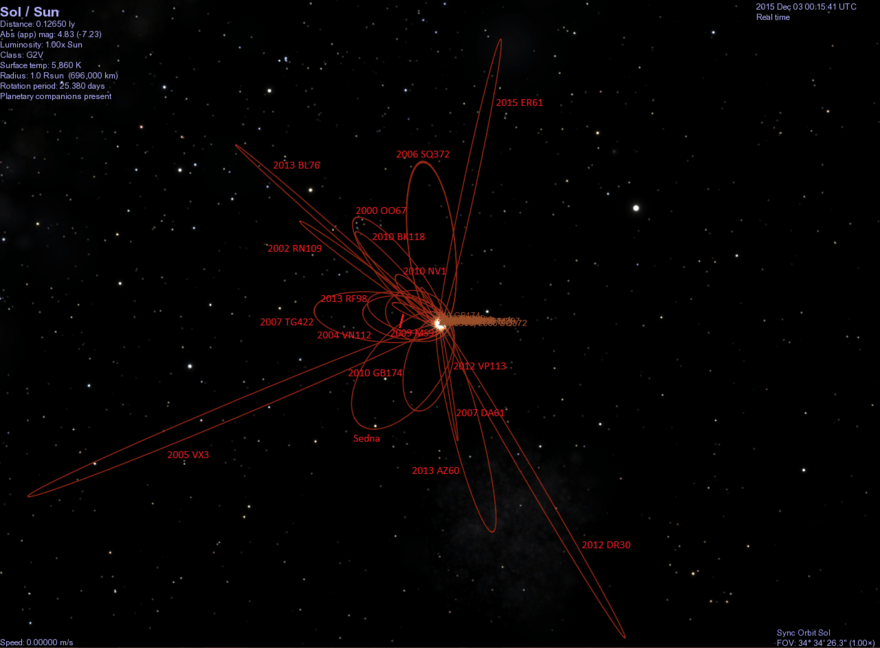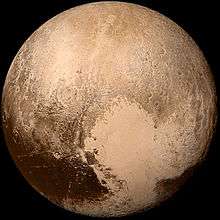2010 GB174
| Discovery | |
|---|---|
| Discovery date | 12 April 2010 |
| Designations | |
| MPC designation | 2010 GB174 |
| detached object | |
| Orbital characteristics [1] | |
| Epoch 2016-Jan-13 (2457400.5) | |
| Observation arc | 2.64 years |
| Aphelion |
693 ± 53 AU (Q) 654 AU (barycentric)[2] |
| Perihelion | 48.7 ± 0.3 AU |
|
371 ± 29 AU (a) 351 AU (barycentric)[2] | |
| Eccentricity | 0.869 ± 0.01 |
|
7150 ± 827 yr 6600 yr (barycentric)[2] | |
| 3.22° ± 0.4° | |
| Inclination | 21.54 ° |
| 130.6° (Ω) | |
| 347.8° ± 0.4°(ω) | |
| Physical characteristics | |
| Dimensions |
223 km (based on assumed albedo)[3] 130–300 km [1][4] |
| Albedo | 0.08 (assumed) [3] |
| 25.2 [5] | |
| 6.6 [1] | |
|
| |
2010 GB174 is a detached object. It never gets closer than 48.5 AU from the Sun (about the outer edge of the Kuiper belt). Its large eccentricity strongly suggests that it was gravitationally scattered onto its current orbit. It is, like all detached objects, outside the current influence of Neptune, so how it got its current orbit is unknown. 2010 GB174 has the third highest Tisserand parameter relative to Jupiter of any Trans-Neptunian object, after Sedna and 2012 VP113. It has not been observed since 2012.[1] It comes to opposition 27 March 2016 in the constellation of Virgo.
It reached perihelion (closest approach to the Sun) around 1952[1] and has moved beyond 70 AU in September 2014.[5] It is possibly a dwarf planet.[3]
| Object name | Distance from the Sun (AU) | Apparent magnitude |
Absolute magnitude (H) | |||||||||||||||||||||||||||||||||||||||||||||||||||||||||||||||||||||||||||||||||||||||||||||||
|---|---|---|---|---|---|---|---|---|---|---|---|---|---|---|---|---|---|---|---|---|---|---|---|---|---|---|---|---|---|---|---|---|---|---|---|---|---|---|---|---|---|---|---|---|---|---|---|---|---|---|---|---|---|---|---|---|---|---|---|---|---|---|---|---|---|---|---|---|---|---|---|---|---|---|---|---|---|---|---|---|---|---|---|---|---|---|---|---|---|---|---|---|---|---|---|---|---|---|
| Current | Perihelion | Aphelion | ||||||||||||||||||||||||||||||||||||||||||||||||||||||||||||||||||||||||||||||||||||||||||||||||
| V774104 | 103 | N/A | N/A | 24 | 4 | |||||||||||||||||||||||||||||||||||||||||||||||||||||||||||||||||||||||||||||||||||||||||||||
| Eris | 96.2 | 37.8 | 97.6 | 18.7 | -1.2 | |||||||||||||||||||||||||||||||||||||||||||||||||||||||||||||||||||||||||||||||||||||||||||||
| 2014 UZ224 | 91.6 | 38.0 | 179.8 | 23.2 | 3.5 | |||||||||||||||||||||||||||||||||||||||||||||||||||||||||||||||||||||||||||||||||||||||||||||
| 2007 OR10 | 87.6 | 33.0 | 100.8 | 21.7 | 2.5 | |||||||||||||||||||||||||||||||||||||||||||||||||||||||||||||||||||||||||||||||||||||||||||||
| 2013 FS28 | 86.2 | 34.6 | 347.6 | 24.5 | 4.9 | |||||||||||||||||||||||||||||||||||||||||||||||||||||||||||||||||||||||||||||||||||||||||||||
| Sedna | 85.6 | 76.0 | 939 | 21.0 | 1.6 | |||||||||||||||||||||||||||||||||||||||||||||||||||||||||||||||||||||||||||||||||||||||||||||
| 2014 FC69 | 84.4 | 40.3 | 106.9 | 24.1 | 4.6 | |||||||||||||||||||||||||||||||||||||||||||||||||||||||||||||||||||||||||||||||||||||||||||||
| 2006 QH181 | 83.6 | 37.8 | 96.7 | 23.6 | 4.3 | |||||||||||||||||||||||||||||||||||||||||||||||||||||||||||||||||||||||||||||||||||||||||||||
| 2012 VP113 | 83.3 | 80.5 | 438 | 23.4 | 4.0 | |||||||||||||||||||||||||||||||||||||||||||||||||||||||||||||||||||||||||||||||||||||||||||||
| 2013 FY27 | 80.2 | 36.1 | 81.8 | 22.1 | 3.0 | |||||||||||||||||||||||||||||||||||||||||||||||||||||||||||||||||||||||||||||||||||||||||||||
| 2014 FJ72 | 71.1 | 38.7 | 152.2 | 24.2 | 5.6 | |||||||||||||||||||||||||||||||||||||||||||||||||||||||||||||||||||||||||||||||||||||||||||||
| 2010 GB174 | 71.1 | 48.7 | 693 | 25.1 | 6.5 | |||||||||||||||||||||||||||||||||||||||||||||||||||||||||||||||||||||||||||||||||||||||||||||
| 2012 FH84 | 68.6 | 45.8 | 80.6 | 25.7 | 7.3 | |||||||||||||||||||||||||||||||||||||||||||||||||||||||||||||||||||||||||||||||||||||||||||||
| 2011 GM89 | 68.3 | 37.2 | 68.8 | 25.6 | 7.1 | |||||||||||||||||||||||||||||||||||||||||||||||||||||||||||||||||||||||||||||||||||||||||||||
| 2015 GR50 | 68.2 | 35.6 | 78.6 | 25.1 | 6.7 | |||||||||||||||||||||||||||||||||||||||||||||||||||||||||||||||||||||||||||||||||||||||||||||
| 2015 GP50 | 68.1 | 35.9 | 89.1 | 24.8 | 6.5 | |||||||||||||||||||||||||||||||||||||||||||||||||||||||||||||||||||||||||||||||||||||||||||||
| 2013 FQ28 | 67.5 | 48.7 | 80.6 | 24.4 | 6.0 | |||||||||||||||||||||||||||||||||||||||||||||||||||||||||||||||||||||||||||||||||||||||||||||
| 2013 UJ15 | 64.4 | 36.3 | 69.2 | 25.2 | 7.0 | |||||||||||||||||||||||||||||||||||||||||||||||||||||||||||||||||||||||||||||||||||||||||||||
| 2015 RR245 | 63.9 | 33.7 | 129.2 | 22.1 | 3.9 | |||||||||||||||||||||||||||||||||||||||||||||||||||||||||||||||||||||||||||||||||||||||||||||
| 2014 SG350 | 63.0 | 39.9 | 63.9 | 24.8 | 6.8 | |||||||||||||||||||||||||||||||||||||||||||||||||||||||||||||||||||||||||||||||||||||||||||||
| 2014 FL72 | 62.1 | 38.2 | 170.4 | 25.0 | 6.8 | |||||||||||||||||||||||||||||||||||||||||||||||||||||||||||||||||||||||||||||||||||||||||||||
| 2013 AT183 | 62.1 | 36.0 | 88.1 | 22.0 | 4.7 | |||||||||||||||||||||||||||||||||||||||||||||||||||||||||||||||||||||||||||||||||||||||||||||
| 2014 FE72 | 61.8 | 36.3 | 4274.0 | 24.1 | 6.1 | |||||||||||||||||||||||||||||||||||||||||||||||||||||||||||||||||||||||||||||||||||||||||||||
| 2014 SV349 | 61.3 | 34.2 | 89.0 | 23.0 | 5.0 | |||||||||||||||||||||||||||||||||||||||||||||||||||||||||||||||||||||||||||||||||||||||||||||
| 2000 CR105 | 60.8 | 44.3 | 412 | 23.9 | 6.3 | |||||||||||||||||||||||||||||||||||||||||||||||||||||||||||||||||||||||||||||||||||||||||||||
| 2014 SU349 | 60.7 | 30.8 | 109.8 | 25.0 | 7.0 | |||||||||||||||||||||||||||||||||||||||||||||||||||||||||||||||||||||||||||||||||||||||||||||
| 2014 FF72 | 60.7 | 37.1 | 63.3 | 24.8 | 6.9 | |||||||||||||||||||||||||||||||||||||||||||||||||||||||||||||||||||||||||||||||||||||||||||||
| 2014 FM72 | 60.4 | 34.4 | 76.6 | 24.1 | 6.2 | |||||||||||||||||||||||||||||||||||||||||||||||||||||||||||||||||||||||||||||||||||||||||||||
| 2014 FH72 | 60.1 | 37.3 | 77.3 | 25.1 | 7.2 | |||||||||||||||||||||||||||||||||||||||||||||||||||||||||||||||||||||||||||||||||||||||||||||
| 2008 ST291 | 60.1 | 42.4 | 154.5 | 22.2 | 4.2 | |||||||||||||||||||||||||||||||||||||||||||||||||||||||||||||||||||||||||||||||||||||||||||||
| 2003 QX113 | 60.0 | 36.7 | 62.1 | 22.5 | 4.7 | |||||||||||||||||||||||||||||||||||||||||||||||||||||||||||||||||||||||||||||||||||||||||||||
| 2015 KH162 | 59.2 | 41.5 | 82.8 | 21.6 | 3.9 | |||||||||||||||||||||||||||||||||||||||||||||||||||||||||||||||||||||||||||||||||||||||||||||
| Including all known objects currently located at least twice as far as Neptune.[6] See List of trans-Neptunian objects for more. | ||||||||||||||||||||||||||||||||||||||||||||||||||||||||||||||||||||||||||||||||||||||||||||||||||
Comparison

Sedna compared to some other very distant orbiting bodies. Including 90377 Sedna, 2015 DB216 (orbit wrong), (87269) 2000 OO67, 2004 VN112, 2005 VX3, (308933) 2006 SQ372, 2007 TG422, 2007 DA61, (418993) 2009 MS9, 2010 GB174, (336756) 2010 NV1, 2010 BK118, 2012 DR30, 2012 VP113, 2013 BL76, 2013 AZ60, 2013 RF98, 2015 ER61
See also
References
- 1 2 3 4 5 "JPL Small-Body Database Browser: (2010 GB174)". Retrieved 2016-01-24.
- 1 2 3 Horizons output. "Barycentric Osculating Orbital Elements for 2010 GB174". Retrieved 2016-01-23. (Ephemeris Type:Elements and Center:@0)
- 1 2 3 Michael E. Brown. "How many dwarf planets are there in the outer solar system? (updates daily)". California Institute of Technology. Archived from the original on 2011-10-18. Retrieved 2014-02-16.
- ↑ "ABSOLUTE MAGNITUDE (H)". NASA/JPL. Retrieved 2013-05-27.
- 1 2 "AstDyS 2010 GB174 Ephemerides". Department of Mathematics, University of Pisa, Italy. Retrieved 2014-03-28.
- 1 2 "AstDyS-2, Asteroids - Dynamic Site". 2016-02-26. Retrieved 2016-02-29.
Objects with distance from Sun over 59 AU
External links
This article is issued from Wikipedia - version of the 9/21/2016. The text is available under the Creative Commons Attribution/Share Alike but additional terms may apply for the media files.
_(cropped).jpg)
